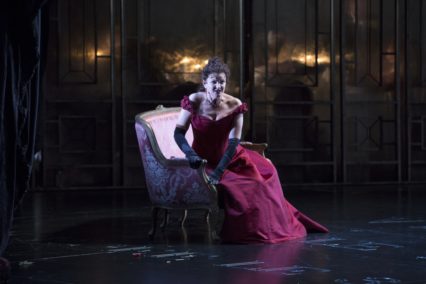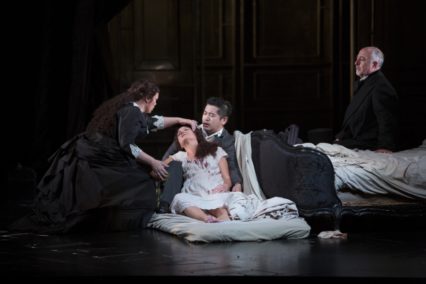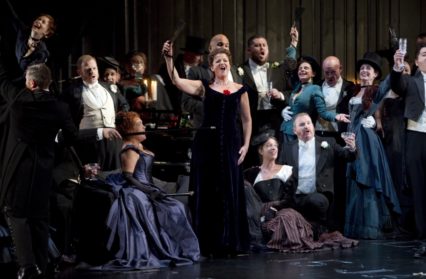Nigel Jarrett attends the La Traviata production by the Welsh National Opera at the Wales Millenium Centre to provide a critical review.

Of all mainstream operas, Verdi’s La Traviata is probably the least in need of a modern twist. David McVicar’s 2009 production for Welsh National Opera, revived for the second time if not overhauled, is traditional to a fault. It came about after the company a few years before had presented a version by other hands that had the eponymous heroine, Violetta, dying in hospital attached to a drip. The implication was that hers was a ‘contemporary’ death, from AIDs may be, which necessitated dragging into the present the milieu – hedonistic lifestyles, capricious friends, and fellow party animals – in which such a malady had sprouted. Like some other attempts in the theatre to skew time frames and make the action ‘relevant’, it was patronising. Death from disease, in Violetta’s case consumption in the WNO production, amid the shallow posturings of the belle époque-cum-fin de siècle and the entanglements of love, duty and sacrifice, has sufficient pertinence to be in little need of updating. That said, being traditional should not mean that anything can be taken for granted, least of all the outmoded chivalry that sees a fallen woman renouncing her love for a man whose father is worried about the effects of his son’s licentiousness on the prim satisfaction of his about-to-be-married daughter. It’s just as well we never see the daughter, piqued at a distance and out of sight in her Provençal domicile, or have to take the father’s word for it that the nuptial discomfiture back home is greater than his own wounded pride.
Designer Tanya McCallin’s black drapes settle funereally on the La Traviata production by WNO, at times seeming about to collapse on to the whole decadent shebang and subsume under mortality not only the ill-fated courtesan but all who are giving her life, though not with much selflessness or beneficence. Add Violetta’s epitaph etched in the black marble floor and the louring sense of what will be a relatively short-lived era – Paris in the late 19th century – and we have a combination that adds serious life-sapping weight to what’s going on. Yet out of it, ever gasping for life in the midst of debt, sacrifice, superficiality, and dishonour, rises one of Verdi’s most accessible heroines, and the one on whom most of our sympathy is focused. Besides the journey she’s undertaking with the Grim Reaper as a guide, a lot of the incident and small talk, as drama, passes almost unnoticed, though McVicar and his revival director Sarah Crisp are keen to tease it out of the crowd. For instance, there is no mention in WNO’s printed synopsis of Baron Douphol’s challenging Alfredo, Violetta’s lover, to a duel after he has insulted her in a jealous rage at the end of the second act. It’s a confrontation never to be referred to again on stage. (Other subsidiary roles are nicely structured, including Rebecca Afonwy-Jones’s Flora, Philip Lloyd-Evans’s Marquis, Howard Kirk’s Gaston, Simon Crosby Buttle’s Giuseppe, James Cleverton’s Baron, Martin Lloyd’s Doctor and George Newton-Fitzgerads’s Messenger. Sian Menir’s Annina is a devotional presence at Violetta’s side.) There is even a sense in which the love, polluted by the claims of convention, takes second place to Violetta’s personal blood-spattered journey, and in which the revelry has already succumbed to the mournfulness.
This is perhaps why, musically, under conductor James Southall in the pit, the first act’s powerful fusion of abandon and personal reflection errs on the side of the latter. The singing of the main trio everywhere is full-throated if sometimes tempered by a lack of convincing body language; it’s in the music but not necessarily in the movement. Kang Wang’s Alfredo is tight-collared as a character though, if a mite unvarying in timbre, always sung with questing for changes in emotional emphasis. His opening protestation of love (Un di felice, eterea) is soulful, his preceding libiamo an invitation to drink which might possibly have seen him partake of something non-alcoholic. Linda Richardson, in the title role, soon has the opportunity to show her mettle in the great four-part scene at the end of the act, when the revellers have momentarily decamped. She is intelligently directed to allow the music to express everything with a minimum of action, which it does, her final Sempre Libera (‘always free’) not delivered, as it is in stand-alone performances, as a sufferer in receipt of a contrary medical opinion. That final top note hovers as close to E flat as doesn’t matter.

Roland Wood, in a marvellously resonant voice, depicts an intimidating Giorgio Germont, Alfredo’s father, beneath whom Violetta, perhaps intentionally (maybe he’s intentionally threatening despite his conciliatory streak) cowers. His intervention almost makes us forget the opening of the first part of act two, in which the lovers’ relationship begins to succumb. Giorgio’s big aria (Di Provenza il mar, il suol) is a tourist board encomium of the delights of the South delivered to his son, who is unmoved. As always it receives applause when the action clearly renders it intrusive.
Wang is up for Alfredo’s change of character in the act two-party scene but not before the diversion of a corrida offered by female gipsy dancers (Colm Seery, Juan Dario Sanz Yagüe, Ashley Bain, Meri Bonet, Lucy Burns, Maria Comes Sampedro, and Lauren Wilson), one of whom turns out to be crossed-dressed and with the hots for a camp matador. The days are gone when this was considered slightly shocking so that when the cross-dresser unmasks himself it seems self-conscious unless it was done in the unlikely event that the matador doesn’t know. (This revival has its own choreographer, Seery, buffing and enhancing Andrew George’s original steps). By now Southall and the WNO orchestra are attuned to the significant change of dramatic pace, in which Wang becomes a bit more unbuttoned and the assemblage, summoned by Alfredo for his denunciation scene (Questa donna conoscete) begins to wonder where the next party might be. Giorgio’s arrival often thought of as an inexplicable turn up for the books, is at least validated in dramatic terms by Wood’s large presence, an example of how all three principals never flag. They are like three ships floating abreast through a sea of frippery; it wouldn’t do for any of them to be left behind. Anyway, Germont senior must have found the waters difficult, obviously considering the northern demi-monde a sink of expensive iniquity. All this is emphasised in McVicar’s production, first made for Scottish Opera and bathed in a delicious haze redolent of Empire by lighting designer Jennifer Tipton.
Southall and the orchestra do despondency very well, not least in the prelude’s opening bars and the start of the third act of La Traviata, itself notable for depicting a life ebbing and flowing. The offstage chorus, nominally a group of partygoers going to their next bash, could have been read as something Violetta in her delirium is hearing as a memory. All along Richardson had expressed vocally both the zest for life and love and its diminishing capacity, her final delusory utterance of vitality reborn (È strano..in me rinasce) quite heartbreaking. It is not a portrayal that draws attention to itself and for that reason may be misunderstood as unexceptional. But it is human and real, and in a slice of Verdi verismo, even one about a lifestyle as remote from most as the overweening Giorgio Germont discovered, demands to be treated as part of a storyline unadorned by ironic interpretation or comment. Knowing when to be hands-off is as important as the invitation to re-invent.
The Welsh National Opera, the team behind La Traviata has a number of other productions available to book via their website.
Header photo of the WNO show is by Betina Skovbro.
Nigel Jarrett is a former daily newspaperman and a regular contributor to the Wales Arts Review and other publications, including Jazz Journal and Acumen poetry magazine. He was formerly music critic of the South Wales Argus. He is a poet, novelist, and story writer. His first collection of stories, Funderland, was warmly reviewed in the Independent, the Guardian, and the Times, and long-listed for the Edge Hill Prize. His latest collection is Who Killed Emil Kreisler?. He is a winner of the Rhys Davies prize for short fiction and, in 2016, the inaugural Templar Shorts award. This year sees the publication of his short fiction pamphlet, A Gloucester Trilogy.



 Enjoyed this article? Support our writers directly by buying them a coffee and clicking this link.
Enjoyed this article? Support our writers directly by buying them a coffee and clicking this link.







